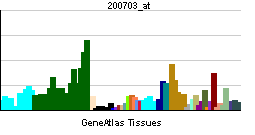DYNLL1
| Dynein, light chain, LC8-type 1 | |||||||||||||
|---|---|---|---|---|---|---|---|---|---|---|---|---|---|
 PDB rendering based on 1cmi. | |||||||||||||
| |||||||||||||
| Identifiers | |||||||||||||
| Symbols | DYNLL1 ; DLC1; DLC8; DNCL1; DNCLC1; LC8; LC8a; MGC126137; MGC126138; PIN; hdlc1 | ||||||||||||
| External IDs | Template:OMIM5 Template:MGI HomoloGene: 37844 | ||||||||||||
| |||||||||||||
| RNA expression pattern | |||||||||||||
 | |||||||||||||
| More reference expression data | |||||||||||||
| Orthologs | |||||||||||||
| Template:GNF Ortholog box | |||||||||||||
| Species | Human | Mouse | |||||||||||
| Entrez | n/a | n/a | |||||||||||
| Ensembl | n/a | n/a | |||||||||||
| UniProt | n/a | n/a | |||||||||||
| RefSeq (mRNA) | n/a | n/a | |||||||||||
| RefSeq (protein) | n/a | n/a | |||||||||||
| Location (UCSC) | n/a | n/a | |||||||||||
| PubMed search | n/a | n/a | |||||||||||
Dynein, light chain, LC8-type 1, also known as DYNLL1, is a human gene.[1]
Cytoplasmic dyneins are large enzyme complexes with a molecular mass of about 1,200 kD. They contain two force-producing heads formed primarily from dynein heavy chains, and stalks linking the heads to a basal domain, which contains a varying number of accessory intermediate chains. The complex is involved in intracellular transport and motility. The protein described in this record is a light chain and exists as part of this complex but also physically interacts with and inhibits the activity of neuronal nitric oxide synthase. Binding of this protein destabilizes the neuronal nitric oxide synthase dimer, a conformation necessary for activity, and it may regulate numerous biologic processes through its effects on nitric oxide synthase activity. Alternate transcriptional splice variants have been characterized.[1]
References
Further reading
- Robertson NG, Khetarpal U, Gutiérrez-Espeleta GA; et al. (1995). "Isolation of novel and known genes from a human fetal cochlear cDNA library using subtractive hybridization and differential screening". Genomics. 23 (1): 42–50. doi:10.1006/geno.1994.1457. PMID 7829101.
- Dick T, Ray K, Salz HK, Chia W (1996). "Cytoplasmic dynein (ddlc1) mutations cause morphogenetic defects and apoptotic cell death in Drosophila melanogaster". Mol. Cell. Biol. 16 (5): 1966–77. PMID 8628263.
- Jaffrey SR, Snyder SH (1996). "PIN: an associated protein inhibitor of neuronal nitric oxide synthase". Science. 274 (5288): 774–7. PMID 8864115.
- Crépieux P, Kwon H, Leclerc N; et al. (1997). "I kappaB alpha physically interacts with a cytoskeleton-associated protein through its signal response domain". Mol. Cell. Biol. 17 (12): 7375–85. PMID 9372968.
- Tochio H, Ohki S, Zhang Q; et al. (1998). "Solution structure of a protein inhibitor of neuronal nitric oxide synthase". Nat. Struct. Biol. 5 (11): 965–9. doi:10.1038/2940. PMID 9808041.
- Rodríguez-Crespo I, Straub W, Gavilanes F, Ortiz de Montellano PR (1998). "Binding of dynein light chain (PIN) to neuronal nitric oxide synthase in the absence of inhibition". Arch. Biochem. Biophys. 359 (2): 297–304. PMID 9808772.
- Fan JS, Zhang Q, Li M; et al. (1999). "Protein inhibitor of neuronal nitric-oxide synthase, PIN, binds to a 17-amino acid residue fragment of the enzyme". J. Biol. Chem. 273 (50): 33472–81. PMID 9837926.
- Puthalakath H, Huang DC, O'Reilly LA; et al. (1999). "The proapoptotic activity of the Bcl-2 family member Bim is regulated by interaction with the dynein motor complex". Mol. Cell. 3 (3): 287–96. PMID 10198631.
- Liang J, Jaffrey SR, Guo W; et al. (1999). "Structure of the PIN/LC8 dimer with a bound peptide". Nat. Struct. Biol. 6 (8): 735–40. doi:10.1038/11501. PMID 10426949.
- Epstein E, Sela-Brown A, Ringel I; et al. (2000). "Dynein light chain binding to a 3'-untranslated sequence mediates parathyroid hormone mRNA association with microtubules". J. Clin. Invest. 105 (4): 505–12. PMID 10683380.
- Naisbitt S, Valtschanoff J, Allison DW; et al. (2000). "Interaction of the postsynaptic density-95/guanylate kinase domain-associated protein complex with a light chain of myosin-V and dynein". J. Neurosci. 20 (12): 4524–34. PMID 10844022.
- Jacob Y, Badrane H, Ceccaldi PE, Tordo N (2000). "Cytoplasmic dynein LC8 interacts with lyssavirus phosphoprotein". J. Virol. 74 (21): 10217–22. PMID 11024152.
- Herzig RP, Andersson U, Scarpulla RC (2001). "Dynein light chain interacts with NRF-1 and EWG, structurally and functionally related transcription factors from humans and drosophila". J. Cell. Sci. 113 Pt 23: 4263–73. PMID 11069771.
- Haraguchi K, Satoh K, Yanai H; et al. (2001). "The hDLG-associated protein DAP interacts with dynein light chain and neuronal nitric oxide synthase". Genes Cells. 5 (11): 905–911. PMID 11122378.
- Lo KW, Naisbitt S, Fan JS; et al. (2001). "The 8-kDa dynein light chain binds to its targets via a conserved (K/R)XTQT motif". J. Biol. Chem. 276 (17): 14059–66. doi:10.1074/jbc.M010320200. PMID 11148209.
- Yano H, Lee FS, Kong H; et al. (2001). "Association of Trk neurotrophin receptors with components of the cytoplasmic dynein motor". J. Neurosci. 21 (3): RC125. PMID 11157096.
- Fan J, Zhang Q, Tochio H; et al. (2001). "Structural basis of diverse sequence-dependent target recognition by the 8 kDa dynein light chain". J. Mol. Biol. 306 (1): 97–108. doi:10.1006/jmbi.2000.4374. PMID 11178896.
- Bielli A, Thörnqvist PO, Hendrick AG; et al. (2001). "The small GTPase Rab4A interacts with the central region of cytoplasmic dynein light intermediate chain-1". Biochem. Biophys. Res. Commun. 281 (5): 1141–53. doi:10.1006/bbrc.2001.4468. PMID 11243854.
- Yu J, Yu L, Chen Z; et al. (2002). "Protein inhibitor of neuronal nitric oxide synthase interacts with protein kinase A inhibitors". Brain Res. Mol. Brain Res. 99 (2): 145–9. PMID 11978406.
- Fuhrmann JC, Kins S, Rostaing P; et al. (2002). "Gephyrin interacts with Dynein light chains 1 and 2, components of motor protein complexes". J. Neurosci. 22 (13): 5393–402. doi:20026552 Check
|doi=value (help). PMID 12097491.
| This protein-related article is a stub. You can help Wikipedia by expanding it. |